Construction ‘jealous’ of other sectors’ robots. Are ‘co-bots’ the answer?
12 July 2024
Recent advances in automation are encouraging a wave of innovation in the construction tech sector. But, as Mitchell Keller finds out, the rapidly changing environment of a live construction site is likely to mean that for construction the future lies not in robotics but ‘cobotics’
In a factory in leafy northern Massachusetts, Amazon’s robotic fulfilment hub streamlines the delivery of sortable parcels destined for delivery across the Northeast USA.
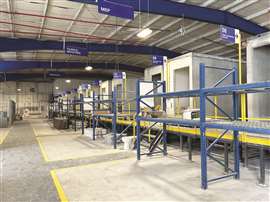 An assembly line for Onx’s prefabricated bathroom units at their factory located in Florida, US (Photos: Mitchell Keller)
An assembly line for Onx’s prefabricated bathroom units at their factory located in Florida, US (Photos: Mitchell Keller)
Once an item is ordered online, it is automatically carried across the warehouse floor by a four-wheeled robotic cart or Drive robot to a human worker who scans it and checks that the product is indeed the same as that displayed on the computer screen in front of them. With that, the item is automatically sent on a conveyor to be packaged and sorted by a robotic arm called Robin whose computer vision picks select packages and sends them via another Drive robot to the correct loading dock.
For those attempting to bring automation to the construction industry, the contrast between the sort of cutting-edge robotics being used in factories and warehouses and the sort of automated machines being used to shorten construction timelines and reduce injuries on building sites, is clear.
“I’m a bit jealous about what’s going on in the automative industry,” says Aviad Almagor, US-based Trimble’s VP of technology innovation. “You see the full automation of the production line, and, to be fair, they have an easier task to solve because the production line is the same.”
Under-the-radar innovations
Yet even as advances in automation and robotics spur a hi-tech revolution in other industries, examples of such innovation on construction sites are less easy to come by and, generally harder to spot.
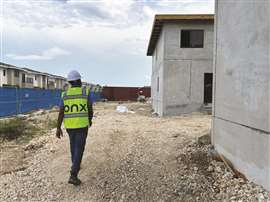
Mason Ford, director of sustainability and equipment services at Skanska says that a robotic future for construction sites is mostly still the stuff of science fiction. That’s due to the fact that scientists still are unable to create robots or automate existing machines to make them quick and agile enough not to bump into objects and people in the quick-changing environment of a live construction site.
“Realistically, it [automation] is rarely feasible in densely populated construction zones,” says Ford. “In these specific projects, the installation of object avoidance technology is essential. In addition to object avoidance technologies, selectively we also employ video surveillance, enabling us to monitor projects closely and identify various hazards as they arise.”
To this end, Ford says that in fact, adding sensing technology to the company’s existing fleet is his main priority, helping human operators to avoid collisions. “Our current initiative is the implementation of blind spot detection technology on every machine that we own and operate by 2025,” says Ford. “What we’re seeing is a lot of the technology out there only focuses on identification, not avoidance,” he adds.
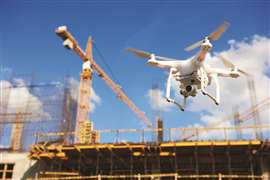 A robotic drone at a construction site (Photo: Adobe Stock)
A robotic drone at a construction site (Photo: Adobe Stock)
“Our hope is for sensors and avoidance technology to be embedded within these machines, intelligently detecting obstacles or individuals, and stopping the machines when necessary. It’s important for industry leaders to continue to challenge the status quo so that we can continue to push for innovation within construction equipment to ensure safer work environments on all project types.”
“We’re very close to our goal of 100% of our equipment fleet having aftermarket or factory OEM technologies on our machines, but it’s crucial for the industry as a whole to maintain momentum in advocating for ‘smarter’ equipment; machines that not only identify hazards but also take action to avoid them once identified.”
Nonetheless, robots and automative processes are playing an ever-increasing role key role in construction’s ongoing battle to become more productive.
Some of the biggest advances in recent years have been in sensing and camera technology, a key component of remote-operated robotics and automated machinery. Drones, which can come outfitted with this tech, are also being used more.
Trimble’s Almagor says that while some parts of the industry may move toward off-site prefabrication or modular approaches, on dynamic construction work sites ‘cobotics’ – robotics that require human collaboration – are likely to become prevalent.
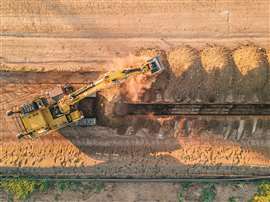 An aerial view of an excavator with a Built Robotics Exosystem doing trench work (Photo: Built Robotics)
An aerial view of an excavator with a Built Robotics Exosystem doing trench work (Photo: Built Robotics)
“Robotic fleets should not be one robot,” says Almagor. “Construction sites will have a mixed fleet with drones and autonomous cranes and the plaster robot and a brick-layout robot; it’s a mix of tools, and each one of them is different and has someone who understands how to operate and maintain the robot.”
And of course, although such an innovation may reduce the number of humans required to do the work on site, increasing automation also increases the need for more skilled operators and technicians on site.
“There’s so much work to do. What we will need to do is to make sure that those employees will be educated to support the robot, because we’re not going to see sites without any humans in the near future,” he adds.
Robots without human characteristics
Perhaps this biggest change in recent years regarding construction robotics is determining what machines are deemed ‘robots’.
“The term ‘robotics’ often conjures images of humanoid robots,” says US-based Advanced Construction Robotics (ACR). “However, in the construction industry, robotics involves various forms of automated machinery tailored to specific tasks; [like] tying or placing rebar.”
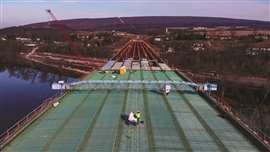 Advanced Construction Robotics’ (ACR) TyBot working a bridge job in Pennsylvania, US (Photo: ACR)
Advanced Construction Robotics’ (ACR) TyBot working a bridge job in Pennsylvania, US (Photo: ACR)
ACR’s TyBot – ‘the rebar tying robot’ – is exactly one of those automated machines, and it has close to zero human-like characteristics.
TyBot looks more like the top of a tower crane than anything, but it’s an advanced robot capable of sensing and navigating its environment without pre-mapping, calibration, or BIM input.
Designed for the roadbuilding and bridge construction segments, TyBot specialises in tying rebar; it works at speeds in excess of 1,200 ties-per-hour using 15-lbs (6.8kg) of wire spool and can tie epoxy coated bar and black bar.
It can stretch to a width of 117 ft (35.7m) or operate as narrow as 10 ft (3.05m). A robotics supervisor accompanies the machine during its 12-hour run, after which point it requires refuelling.
“Our robotic solutions not only address labour shortages but also significantly improve workplace safety by taking on the most hazardous tasks, such as heavy lifting,” says Danielle Proctor, CEO of ACR. “This reduces the risk of injuries and improves overall job satisfaction. Furthermore, by streamlining processes and reducing waste, our technologies contribute to sustainability in construction, aligning with environmental standards.”
Retrofitting existing machinery
Other robotic machines in the industry weren’t initially designed to be automated, but thanks to Built Robotics – a US-based utility-scale automated-equipment manufacturer – existing construction units can be outfitted with robotic capabilities.
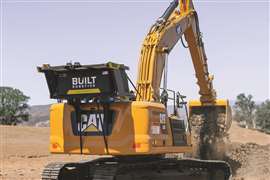
Erol Ahmed, director of communications with Built, says, “We have something we call an Exosystem, and this is a set of software and hardware that we could put on almost any kind of heavy equipment and turn it into an autonomous machine or robot.”
Ahmed says Built has focused on using its application for dozers, vibrators, and excavators, all of which play important roles in large-scale solar panel installation.
“Solar is a very automatable kind of process,” he says. “You’re putting in hundreds of thousands of certain items on solar farms in a consistent fashion. So, it’s one of the few construction tasks that is really well aligned with what robots can do.”
Tasks like trenching and drilling, with Exosystem, can be automated using non-automated machines, offering flexibility for contractors and rental groups that may not have capital to add newly-developed robotics.
The machines’ work is as precise as a purpose-built automated unit, Ahmed says.
“When we’re talking about solar construction, we’re talking about some measurements at sub-centimetre. We install at very strict tolerances, so you’re looking at a level of precision you’d expect [from a fully-automated machine],”says Ahmed, noting Exosystem machines allow operators to monitor and react from safe distances. They work more consistently, more safely.”
STAY CONNECTED



Receive the information you need when you need it through our world-leading magazines, newsletters and daily briefings.
CONNECT WITH THE TEAM








